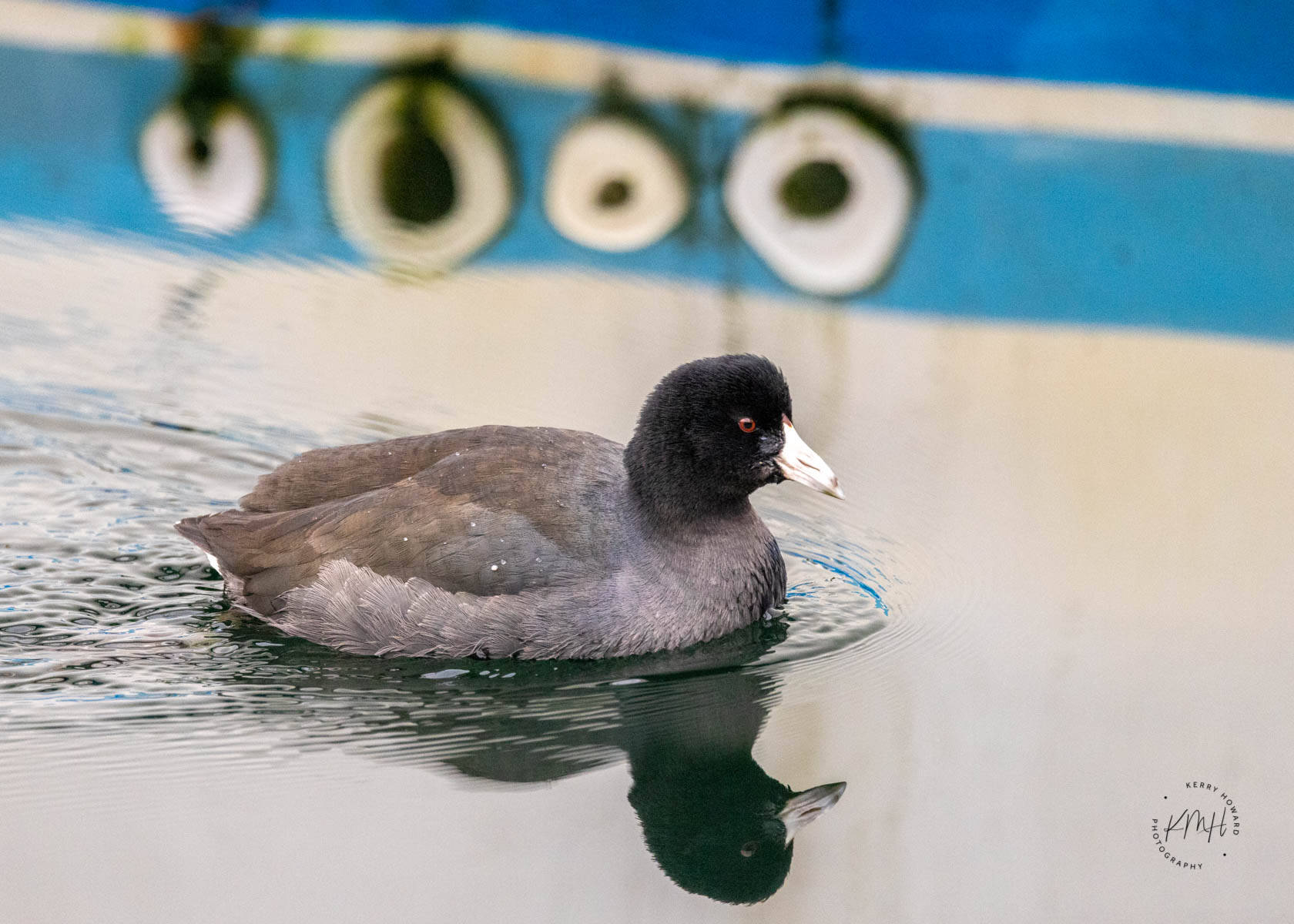By Mary F. Willson
For the Juneau Empire
Regular bird-watchers spotted an unusual bird in Auke Bay this winter — an American coot. Although range maps show occasional migrants in southern Yukon, at the present time the Auke Bay record is the most northern, according to ebird. Coots are members of the rail family, which includes the sora that is often found in the Pioneer Marsh in summer. Most coots breed farther south of here, but there are isolated breeding populations in east-central Alaska and southern Yukon; this individual is presumably doing its winter things and may migrate north later.
Although they sometimes use salt or brackish water on migration, coots typically nest in freshwater marshes with fairly deep water and lots of tall vegetation. They eat mostly aquatic vegetation, but also take small animals, both invertebrates and vertebrates, at times. Food is gathered by dipping the head underwater or by diving, and usually brought to the surface for swallowing. They sometimes feed on carrion, or steal from ducks, or even snatch flies out of the air. They are strong swimmers; they don’t have fully webbed feet but they have toes with lobes on the sides that increase the size of the foot paddle.
Coots are strongly territorial, vigorously defending a nesting territory again other coots, as well as ducks, grebes, and sometimes other birds. They are socially monogamous, but in some populations there seem to be floater females that lack a mate and a territory and these females sometimes dump their eggs in the nest of a mated pair. Nests are placed on floating platforms of vegetation, often anchored on the sides by tall cattails and reeds. Multiple platforms are built by each pair and used for courtship, and one is used for the nest. The nest itself is made of small bits of vegetation, making a smooth basket big enough to hold the eggs, although this tends to get trampled flat by the time chicks are present. The floating platform tends to sink, so the parents have to continually repair and augment the structure.
A normal clutch size is about eight to 12 eggs per nest; larger clutches are probably due to the activities of egg-dumpers. However, most of the dumped eggs do not produce chicks, because the nest-owners usually reject the excess eggs. Both parents incubate the eggs, the males mostly at night. Incubation takes a little over three weeks, and the eggs hatch over a span of about three days. Chicks can hop out of the nest and swim around just a few hours after hatching, calling loudly for food to be delivered. Long ago, when I was doing my thesis research in the marshes of eastern Washington, I was fascinated by the goofy appearance of those little chicks, as they swam around after the parents. They have thick black down feathers with stiff, curly, orange tips, a nearly bald head, with some bluish patches above the eyes, that’s fringed with red or orange frizzy feathers, and a mostly red bill. It turns out that the oddball coloring is important in stimulating the parents to deliver food. Young birds are chased out of the parent’s territory after about three months, to live on their own and mature at age one year.
Also appearing this winter is another critter that is rare around here: Fishers live in northern forests across North America, but only recently (since the mid 1990s) have they been recorded in Alaska and southern Yukon. These pioneers are thought to arrive via the Taku River valley. Fishers belong to the weasel family (Mustelidae), smaller than wolverines but larger than marten. They climb well, because (like squirrels) they can rotate their hind feet so the toes point back; they are active year-round. Like other members of this family, they are fierce predators, capturing mostly rodents, hares, and grouse, but also eating carrion, insects, and fruit—but not usually fish, despite their name. Fishers are very good at killing porcupines, biting the face and then flipping them over to rip open the belly. They also sometimes prey on marten and weasels, and research has shown that these smaller mustelids tend to avoid times of peak foraging by fishers.
Although males and females mature at age one year, most successful breeding starts at age 2. Dens for mothers and kits are usually in cavities in big logs and trees. Kits are generally born in early spring, and females come into estrus and mate a few days later. Sperm meets eggs and a fertilized zygote is formed, but it does not develop very much right away; instead, it just rests in the uterus until late winter, when it is implanted in the uterine wall and active development begins. Litter size is commonly two or three kits, weighing less than 2 ounces each, which depend on mother’s milk for at least three months and may be weaned at four months. By early fall, they are about full grown; males usually weigh about twice as much as females.
One more little surprise: a trail cam in the Dredge Lakes area has recorded significant beaver activity in the middle of winter, despite heaps of snow and some very low temperatures. Small trees have been chopped down and hauled away, presumably for food. We seldom see winter activity like this around here. Adult beavers typically live on stored fat reserves while remaining in the lodge in winter. However, kits keep growing through the winter months, and they need to eat. They usually feed on a cache of sticks in front of the lodge, but maybe this family didn’t make a big enough cache.
• Mary F. Willson is a retired professor of ecology. “On the Trails” appears every Wednesday in the Juneau Empire.

